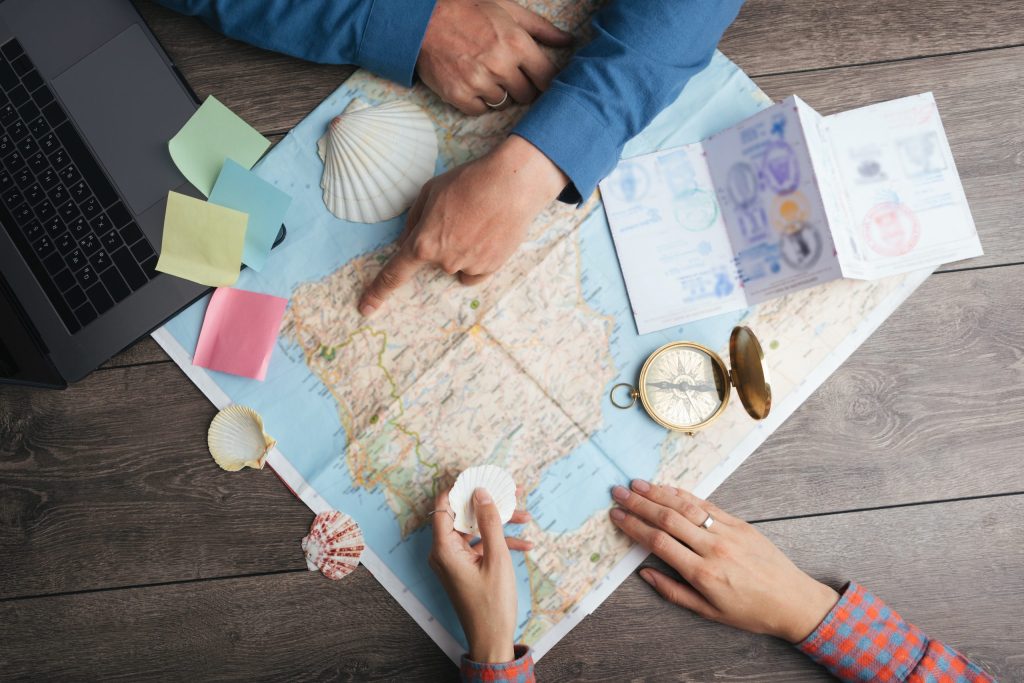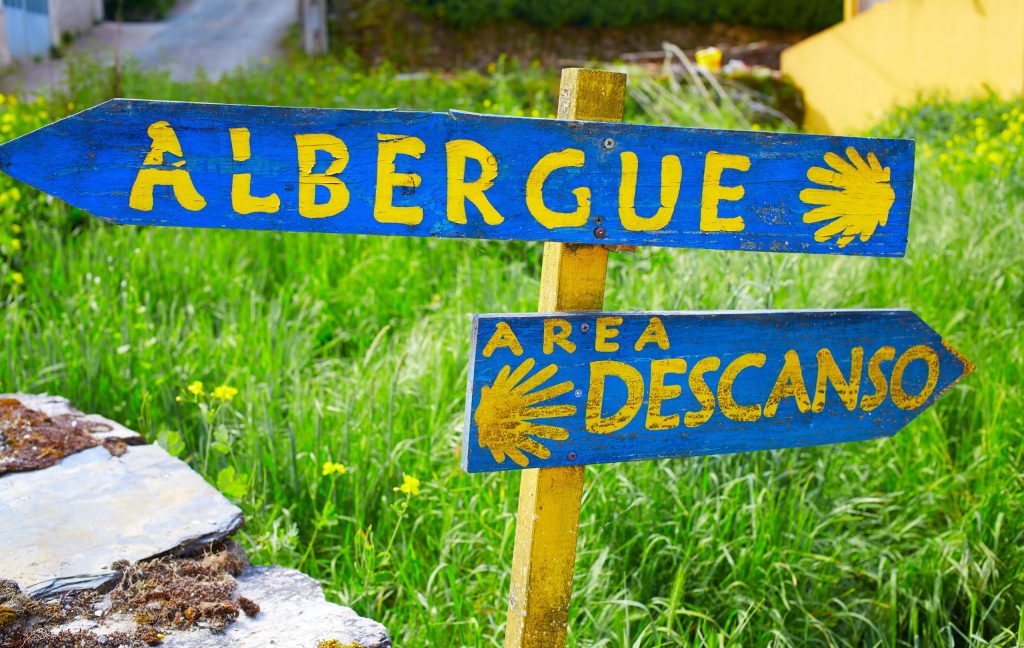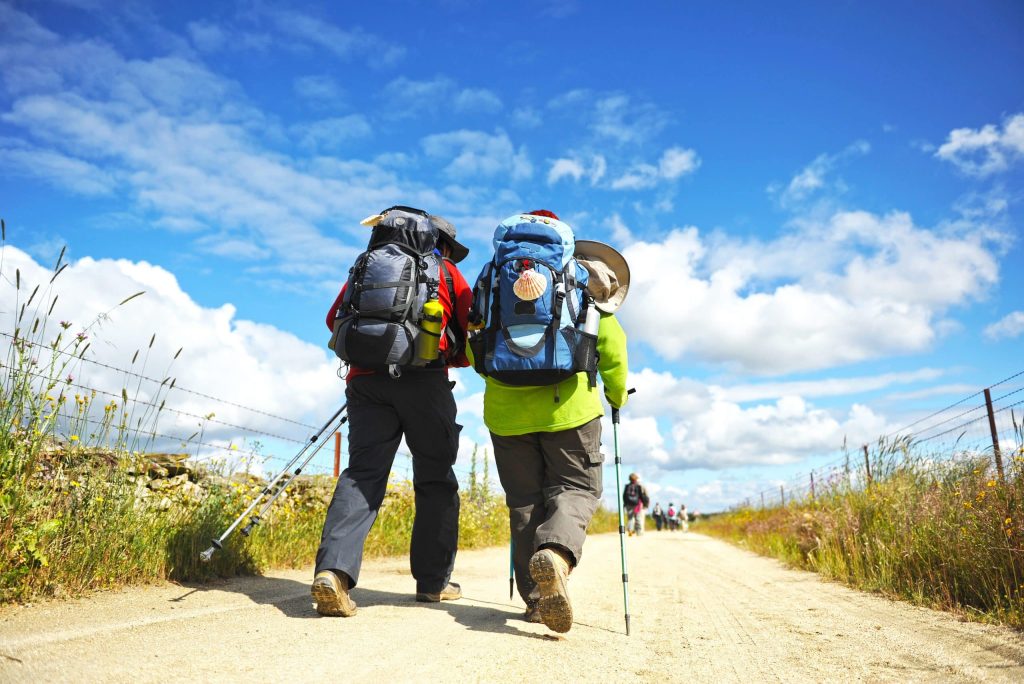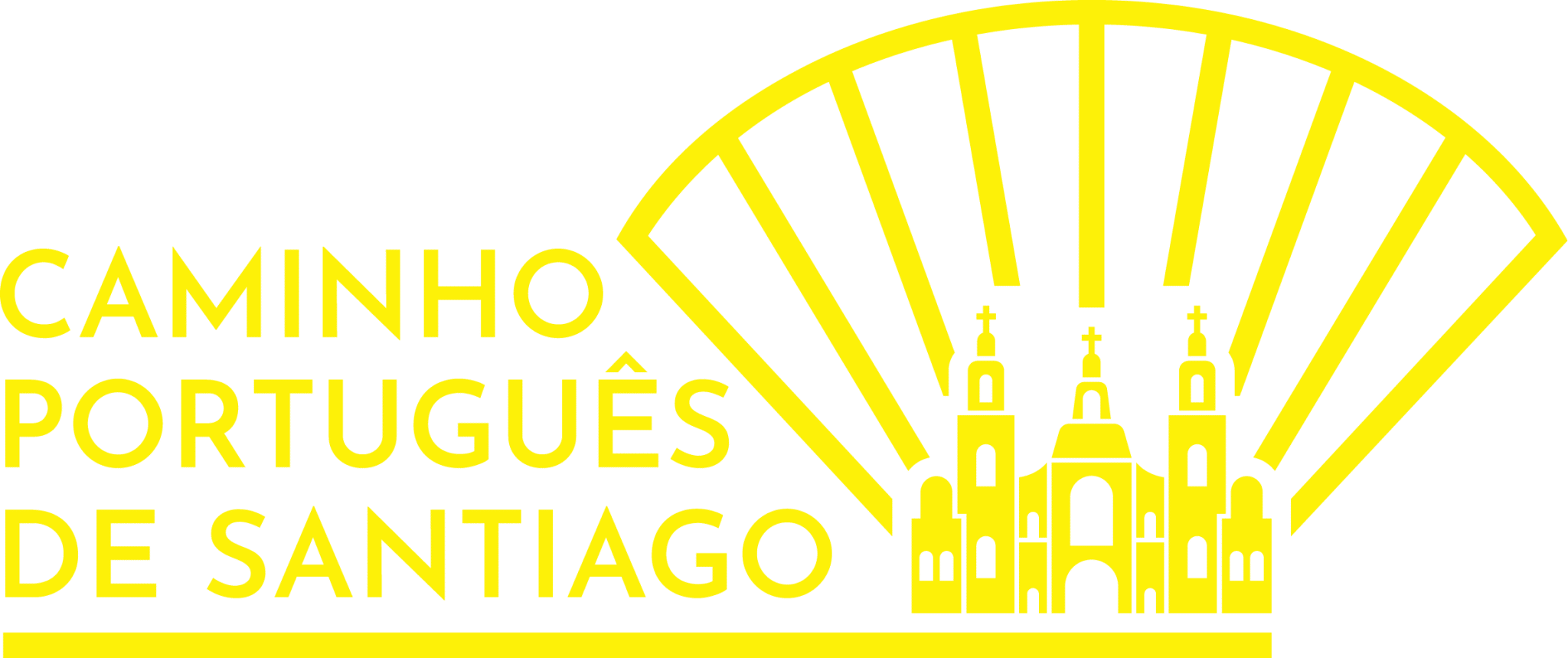Every day, we receive dozens of questions about the Portuguese Way of Saint James in our group. From stays to routes, none is left unanswered by our moderators and members. However, as not everyone has Facebook, we decided to leave the usual questions here, to help everyone in the organization of the trail to the Galician capital.
We have taken the 50 questions about the Camino de Santiago from various pilgrim groups scattered around the Internet. Since there are so many, we divided the questions by different themes.
Questions about what to bring
Before you start your millennial journey, there will be many questions running through your head. Where am I going, who am I going to meet, and what do I need to pack? You are not alone. All pilgrims have questions about changes of clothes, shoes and even the best hats. The important thing is not to let any question interfere with your process. So in this section, you’ll find out what shouldn’t be missing from a pilgrim’s backpack and, above all, what’s okay to leave at home.

Not too heavy, not too light. Backpacks need to carry only what you need.
1) What kind of backpack should I use?
While we can’t suggest a specific model, there are certain features that deserve your attention. First, it should have space for at least 35 liters, but never more than 40. This way, you’ll avoid overpacking, as you’ll have a smaller backpack. Your back will thank you for it in the first 10 kilometers. Secondly, it should have a rigid frame and waist straps to distribute the weight across your shoulders and waist.
2) And how heavy should it be?
As little as possible. You can find the recommendation of 10% of our weight on the internet. We even wrote an article with it. However, this equation only tells part of the story. For example, a person weighing 120 kilograms in principle does not need a backpack weighing that many kilograms. The person may even be tall, but their clothes don’t weigh that much. However, a pilgrim on whom the scales always touch 50 is not going to leave a sleeping bag at home just to be average.
This means that, while it is a good suggestion to consider, it does not contain all the necessary answers. So the most comfortable one for us is: the less the better .
3) What can’t be missing from a pilgrim’s backpack then?
Excellent question! In addition to the backpack itself, it is also important to have a sleeping bag or blanket to cover yourself at night, two changes of clothes and a first-aid kit. In the latter, we are counting basic hygiene products such as toothbrush, paste and shampoo (small bottles or samples are perfect).
Other than that, you only need the spirit of adventure. But we’re sure you already have it! If you want to read more about backpack organization, you can check out our article on the subject here.
4) Am I required to carry the pilgrim’s credential?
Yes, as this document proves that you are making the crossing under the name of Jesus’ apostle. It also gives you access to hostels, the pilgrim menu and the Compostela welcome on arrival in the Galician capital.
5) Where can I buy it?
You can buy the pilgrim’s credential before or after you start the walk, in: associations friends of the way, hostels, in churches along the way or even at the aid stations!
6) At this time of year, is it necessary to wear a windbreaker?
Even though this question was asked in the summer, it fits all times of the year. Along the way, the more experienced pilgrims share their wisdom with us. Thus, one of the most heard pieces of advice is always: “In Galicia it always rains!” This way, it seems wise to think about bringing one, even if just in case.
7) Should I take the pilgrim’s shell?
It looks like it, but it’s not a requirement! However, if you want to take one as a souvenir, our pilgrims from the Caminho Português de Santiago group tell us it is possible to buy them along the way, in cafes and hostels.
8) What is the most appropriate footwear for the Way to Santiago?
The best footwear is the one you already have! Especially if you are planning to buy a new pair just for the millennial trail.
As for boots or sneakers, it’s a personal choice. The former are great for cold and rainy months. The latter, as long as they are not too light, will also fit without any problem.
9) Does anyone have any suggestions for hats to take in the summer?
The hat is an element in the equipment of any hiker, particularly in the warmer months. So, from some with brims, to the more sporty ones, the important thing is to always have a layer of protection between you and the sun.
10) Are walking sticks necessary?
Professionals on the trail say that walking sticks must always be used. However, it is your choice. Either way, the benefits of this tool are obvious. They give you more stability in your stride, which will prevent those embarrassing falls and take away the fear of making the steep descent to Redondela.
11) Is there an app that I should download so I don’t get lost?
You can always use our website, at caminhoportuguesdesantiago.eu, which has personalized maps with itineraries designed by pilgrims for pilgrims. However, we also recommend the Camino Ninja app, which is perfect for finding each other in times of distress.
Questions about preparations
Besides the weight of the backpack, you have to plan the Way. Which one are you going to do? When? These are the simplest questions, since they depend only on you and the time you have available. However, there are certain documents, such as a citizen’s card, that are mandatory to make the millennial journey in safety. This and other questions are answered, here!

Planning is an essential phase of the journey. All steps can be thought through beforehand, however, it is good to leave room for improvisation.
12) Can anyone tell me if I need to register to do the path?
This is a question that sometimes appears in our facebook group. However, the path does not have any kind of registration or price. However, the closest thing to paying an entrance fee is the pilgrim certificate. But this can be purchased before or during the adventure, so you can access the hostels and the pilgrim menu. So follow your heart and start whenever you want! There are stories of people who, one day, started walking to Santiago after seeing the walkers from their window. We’re not telling you to have that level of impulsiveness, but some of it is okay!
13) Where should I start the Camino de Santiago?
At any stage of the route. Most people start in Porto, as it is difficult to have the time and mental availability to start the journey in Lisbon. However, to get to Compostela you only need to walk 100 kilometers to Santiago. However, if you are not interested in this, the opening location should be as comfortable as possible for the Camino you propose to do.
14) Do we need to plan stages?
The best plan would always be to go with the wind and the road. However, this is not possible for most people due to the huge responsibilities we all carry. In other words, while you don’t need to plan your stages, it’s best to know the route you’re going to take as soon as possible. This will help you book hostels if you feel the need, and figure out when you will arrive in Santiago so you can buy your return ticket. Or arrange the ride, of course.
15) Which of the Pathways should I choose?
It’s a matter of preference, as they are all different from each other. Which area of Portugal and Galicia are you most curious about? Do you prefer the sea or the mountains? These answers will help you select the best crossing for you. Also, read our article in which we wrote about the main Portuguese routes,here!
16) Is there any difference between the routes?
The Camino de Santiago is a transformative trail. Thus, each step tells a different story and every day is new. However, between the Coastal route and the Central route, the landscape also changes completely. On the former, we always go close to the sea. So it’s important to wear plenty of sunscreen! On the second, the route to the Galician capital takes us through the Portuguese mountains and hills.
17) What are the best months to walk the Camino?
The advice given to all pilgrims is to avoid the peak vacation season. As this is the time when most people are off work and therefore have time to walk, the route is crowded with pilgrims. The company is good, but you lose some of the calm that the ancient trail demands. We therefore recommend the months of May and September. The heat is still there, but without the vigor of August and there is more space in the hostels. However, the truth is that any time is a good time to do the Camino de Santiago!
18) What is the average cost per day?
This is a question that depends on your style of pilgrimage. A person staying in hotels will have a more expensive walk than someone who prefers public hostels. However, there is an average taken from the book of our pilgrim writer, Agostinho Leal, which tells us the following:
“(…) there’s a rule of thumb that works for most pilgrims: one euro per kilometer! It’s true, five to ten euros for the hostel, ten euros for the pilgrim menu, and another ten euros for other meals. (…) it’s all about doing the math.”
So we have an average of about €1 per thousand meters. That is, if you leave Porto, you will spend between 250 euros and 300. If you don’t get lost, of course.
19) How can I divide the stops in each city?
All the answers are different. The good and pleasant thing would be to follow the maxim, if you are tired, stop, if you are hungry, eat. However, most people cannot afford to go without a return date, all the way to Santiago de Compostela. Many would not even feel comfortable! So the best thing to do is to have set days to do the route. From there, you can use our website, caminhoportuguesdesantiago.eu, to plan your trip. However, there are no scripts on the Camino de Santiago! The stages we have created are just suggestions!
20) Where can I get the European Health Insurance?
You can ask for the EHIC, at Segurança Social Direta, with a password or Citizen Card to access the service.
21) There are ATMs along the way that will charge you a fee to withdraw money, but there are also some that don’t charge fee. Can anyone tell me which ones do not have a fee?
This is a question that worries people who don’t have a Portuguese or Spanish bank account. And the answer, as usual, changes depending on which country you are in. In Portugal, there are no withdrawal fees for debit cards.
But we need to pay attention to the orange boxes: the ATMs. For those who travel with a dual card, that is, debit and credit in the same account, will always pay the “fees”, since this service always opts for the second option.
In Spain, it is different. Unlike in the country of Camões, at the vast majority of ATMs, you pay a withdrawal fee. However, our Caminheiros always come to each other’s aid. So, if you need to withdraw money from your account in Spain, use the ATMs of “A Banka”, as they don’t charge anything.
Questions about accommodations.
The stay always raises questions. Is it safe, is there a risk of staying without a place to sleep, how much do they cost? Despite all these questions, the truth is that the Way to Santiago, especially the most traveled routes, has options for all tastes. Find out more here!

Hostels are the meeting point on the Way to Santiago. Affordable prices, thought of just for pilgrims.
22) Do I need the pilgrim certificate to stay in a hostel?
Yes. You must also always present your identification document, such as your passport or citizen card.
23) Is it necessary to make a reservation in the hostels?
At the height of summer you might have to. The public hostels have a rule that whoever arrives first, on foot, gets the bed. After that, cyclists have priority, and finally, people who travel by other means.
This way, it is possible that you may arrive in a city and everything is already full. One way to counter this fear is to book a private hostel beforehand. This way, you are free to take your time to marvel at the beauty of the road, knowing that when you arrive, you will have a bed and a shower waiting for you.
However, if it is the case that you make a point of going without plans and find yourself in this situation, try your luck in chapels and other religious places. Often they offer what little they have, such as a corner on the floor. That’s why it’s important to bring a sleeping bag in case you have to sleep in a monastery’s kitchen.
24) Can I sleep late?
No. The hostels have a notice of the pilgrims’ departure time and this must be respected, because people have to prepare everything in order to receive the next walkers.
25) Do the hostels offer breakfast?
On a regular basis, only the private ones have that kind of service. However, there is always a kitchen to eat something at dawn.
26) Can I wash clothes in the hostel?
In the vast majority of hostels (we never found one where this was not the case) you can wash your clothes. The choices tend to be between doing it manually, in a tank, or using a washing machine. The latter always has an extra cost.
27) Can I stay overnight at the Hostel the night before the first day of the beginning of the path?
Yes, all you need is your pilgrim certificate and proper identification.
28) Does anyone know of a public Hostel in Santiago? (Or other steps)
Usually when pilgrims refer to public hostels they mean hostels where you pay a donation. In Santiago we count at least 3: Seminario Menor hostel, San Lázaro pilgrims residence and the Albergue Fin del Camino.
Nevertheless, you can find other shelters such as pensions and hotels on our website. At each stage we have a selection of stays to ease your way.
29) Are dogs allowed in hostels?
In some they are! If you want to take your furry friend, you’ll need to organize yourself differently from the other pilgrims. The best thing to do is to mark the stages you want to do and call the hostels to ask if dogs are allowed inside.
Questions about biking the Camino.
The first pilgrims made the journey on foot, but today we can also go on a bicycle. This way of making our way to Santiago, because it is different, also brings several questions. Therefore, it is necessary to think about what else to take, and even to measure to count the days one more time!

The Way to Santiago can be walked in many ways. The bicycle has gained popularity in recent years.
30) Is it better to do the Way to Santiago on bike or on foot?
For those who don’t know how to ride a bicycle, the best thing is to go on foot! Either path, however it is done, is unique. However, both have different characteristics. You can learn more in this article on the subject.
31) To walk the way to Santiago from Porto on bicycle, what is the average number of days to finish the route ?
It depends on your expectations. For experienced cyclists it may take only 3 days. But for most, 5 to 7 is best. Not only does it give you time to see the sights, but the physical exhaustion is less intense.
32) Is there a bike shipping service in Santiago?
Yes, there is! You can find more information here. However, if you prefer to take your bike with you always by train, you can always use this means of transportation. According to our pilgrims, in Portugal, the intercity trains allow 2 bikes per carriage, whereas in the alfa trains you have to disassemble and pack it as luggage. In Spain, from Santiago to Vigo, pilgrims can take 3 bicycles per carriage. So it’s best to buy your tickets in advance, always letting them know you’re bringing your wheeled companion!
33) What should not be missing in the backpack of those who go on the Way on bicycle?
A bike-saving kit, of course! This includes a Swiss army knife, tire disassembly and assembly tool, bike lubricant , inner tube and tire patches, and a hand air pump.
Questions about physical preparation and health.
The Road to Santiago requires us to make a great physical and mental effort. Therefore, many questions arise from this insecurity. Will I be in shape to go to the capital of Galicia on foot? What if I get too tired? However, no fear, because pilgrims help each other and have answers for everything. You can find them here:
34) What do I do if I feel my heart beating too hard?
Be calm! You’re making a huge effort. most likely, you even have the sun beating directly down on you. In these cases, the best thing to do is to find some shade and rest. And never take off your shoes, as your feet swell up and then it becomes more painful to walk! When you recover, you can continue.
35) How fit do I have to be to walk the Way?
There are reports of people with serious health problems who finished the Way to Santiago, like Anselmo. However, there are walkers with sporting habits who left the route halfway. Not being a certain answer, this is a path of medium difficulty.
The best thing for you to do is train well, with a heavy enough backpack and the footwear you will wear until the end of the millennial trail. This is because often it’s not the physical pain that forces you to stop, but the mental difficulty and effort to stride so many kilometers a day. To help you, we have written an article about preparing for the Way to Santiago.
36) I have health problems and cannot carry my backpack, are there transportation companies to carry it in my stead?
Of course there are! This is a service that is used a lot. Especially by people who have difficulties moving around or who can’t carry weights.

37) What should you do in case of blisters on your feet?
Blisters are the most common injury on the trail and, along the way, every day we meet someone complaining about this ailment. In this case, the best remedy is prevention. Blisters are the result of repetitive friction on the skin. That’s why you need to buy the right shoes, well worn in, to avoid creating this reservoir of fluids. But be aware that if blisters are causing excessive pain, stopping is the only option. Infections are recurrent in these situations, and the consequences are far worse than leaving the path halfway through.
Other questions about the Camino de Santiago
We also leave you with some questions that are not entirely in keeping with the previous sections. From safety to meals, there is no question off-topic on the Camino de Santiago. So here are some answers!

Pilgrims walking with companions.
38) Is it safe to walk alone?
This question is most often asked by women. Since we cannot guarantee 100% the safety of the Camino, we can only write about our personal experience and that of other walkers. That is why we have this article.
39) Is there a place where you can find groups that do the Way?
In our Facebook group, there are always pilgrims looking for people to walk the Way.
40) Is it better to do the Camino alone or accompanied?
This is a question that each person has to answer for him/herself. The best thing would be to experience both sensations, however, if this is impossible, know that it is said that “on the Camino you are never alone”.
41) Do I need to show my vaccination certificate before entering the hostels?
It seems like a question from another time, but it is always valid. At the moment, there is no need to show it. However, this answer may change depending on the evolution of Covid-19.
42) What are the meals like on the Camino?
Whether you are hungry or want to eat, every meal on the Camino de Santiago is special. They may not be great dishes, designed by a haute cuisine chef, but the pilgrim menus are prepared to give energy to the walkers for a symbolic price. Most restaurants have this option, so take the opportunity to fill your belly.
43) What should I do to receive the Compostela?
The Compostela is the document that certifies the completion of the Way of Saint James. To receive it, you just need to have your pilgrim’s credential stamped at least twice a day. Then, before arriving in the capital of Galicia, register at www.oficinadelperegrino.com. After your first steps in the Plaza del Obradoiro, go to the pilgrim’s office to collect your certificate.
44) Is the Serra da Labruja really that high?
It is the highest point in Portugal on the Central Way. For this reason, it divides opinion. There are those who do it without much difficulty, moving easily between the green and the mountains. However, for others, it is the most difficult moment.
45) Should I worry about the animals along the way?
No. Most of the animals you’ll meet on the way are local cows and sheep. They are always locked up, so they don’t make the path themselves.
46) When I arrive in Spain, do I need to present my documents at the border?
No. In Valença, crossing is done by pedestrian. The physical border is the bridge connecting the two countries and there are no police. On the other hand, going by the small boats, you just need to present your pilgrim certificate to receive the stamp.
47) Some of the stretches seem dangerous, should I keep walking by the road?
No. None of the steps should seem unnecessarily dangerous. If you feel any kind of insecurity, turn back or review your steps.
48) Is the Way well signposted?
In the great majority of the variants, the Way is well signposted with the typical yellow arrows.
49) Upon arriving in Santiago, I prefer to return home. Are there transportation options available?
Yes, the buses and trains are very close to the city center. It might be better to buy the tickets in advance, so you can leave at a time that suits you.
50) What does it mean, “Good Way?“
Good Way, or Buen Camino, is the pilgrim’s greeting. If you receive it, return it, also saying, Good Way! But if you hear “Ultreia”, you must reply “Et Sulteia”! To understand, read this article on the subject.
We know you have more questions about the camino to ask. So don’t worry, share any questions you have in the group before embarking on this wonderful journey that changes us physically and spiritually. Have a good journey!
